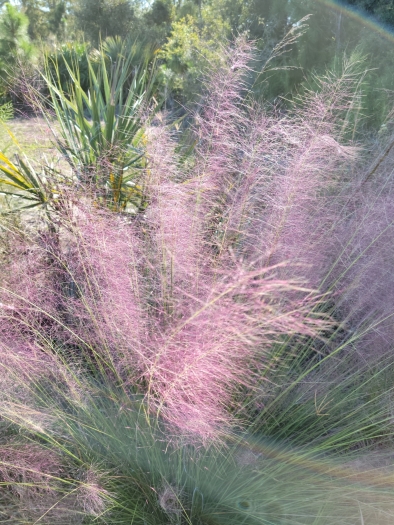Sweet Grass
(Muhlenbergia sericea)
Sweet Grass (Muhlenbergia sericea)
/
/

Jay Horn
CC BY 4.0
Image By:
Jay Horn
Recorded By:
Copyright:
CC BY 4.0
Copyright Notice:
Photo by: Jay Horn | License Type: CC BY 4.0 | License URL: http://creativecommons.org/licenses/by/4.0/ | Rights Holder: Jay Horn | Publisher: iNaturalist | Date Created: 2021-10-18T16:07:38-07:00 |
















Estimated Native Range
Summary
Muhlenbergia sericea, commonly known as Sweet Grass or Muhly Grass, is a perennial grass that is deciduous or semi-evergreen depending on the climate. It is native to a variety of habitats including coastal prairies, pine barrens, and savannas in the Southeastern USA, extending to Texas and north to New Jersey. This grass typically reaches a height and width of 3-4 feet (0.9-1.2 meters), forming dense clumps of fine, blue-green foliage. In the fall, it produces airy, pink to purplish flower plumes that are highly ornamental and persist into winter, adding visual interest to the landscape.
Sweet Grass is valued for its low maintenance requirements and its striking floral display which can create a soft, cloud-like effect in gardens. It is often used in mass plantings, as an accent in borders, or in naturalized areas where its fine texture contrasts well with broader-leaved plants. Sweet Grass prefers full sun but can tolerate light shade, and while it is drought-tolerant once established, it performs best with occasional watering and well-drained soils. It is not commonly associated with serious pests or diseases, making it a resilient choice for gardeners. However, it can self-seed and spread, so it may require management in smaller spaces.CC BY-SA 4.0
Sweet Grass is valued for its low maintenance requirements and its striking floral display which can create a soft, cloud-like effect in gardens. It is often used in mass plantings, as an accent in borders, or in naturalized areas where its fine texture contrasts well with broader-leaved plants. Sweet Grass prefers full sun but can tolerate light shade, and while it is drought-tolerant once established, it performs best with occasional watering and well-drained soils. It is not commonly associated with serious pests or diseases, making it a resilient choice for gardeners. However, it can self-seed and spread, so it may require management in smaller spaces.CC BY-SA 4.0
Plant Description
- Plant Type: Grass
- Height: 3-4 feet
- Width: 3-4 feet
- Growth Rate: Moderate
- Flower Color: N/A
- Flowering Season: Spring
- Leaf Retention: Evergreen
Growth Requirements
- Sun: Full Sun
- Water: Low
- Drainage: Fast
Common Uses
Bank Stabilization, Bird Garden, Butterfly Garden, Deer Resistant, Drought Tolerant, Fire Resistant, Low Maintenance, Salt Tolerant, Street Planting
Natural Habitat
Coastal prairies, pine barrens, and savannas
Other Names
Common Names: Dune-Hair Grass, Purple Muhly, Gulfhairawn Muhly, Gulf Hairawn Muhly
Scientific Names: , Muhlenbergia filipes, Muhlenbergia sericea, Muhlenbergia capillaris var. filipes, Stipa sericea, Agrostis sericea, Podosemum filipes, Polypogon sericeus, Stipa cericea,
GBIF Accepted Name: Muhlenbergia sericea (Michx.) P.M.Peterson